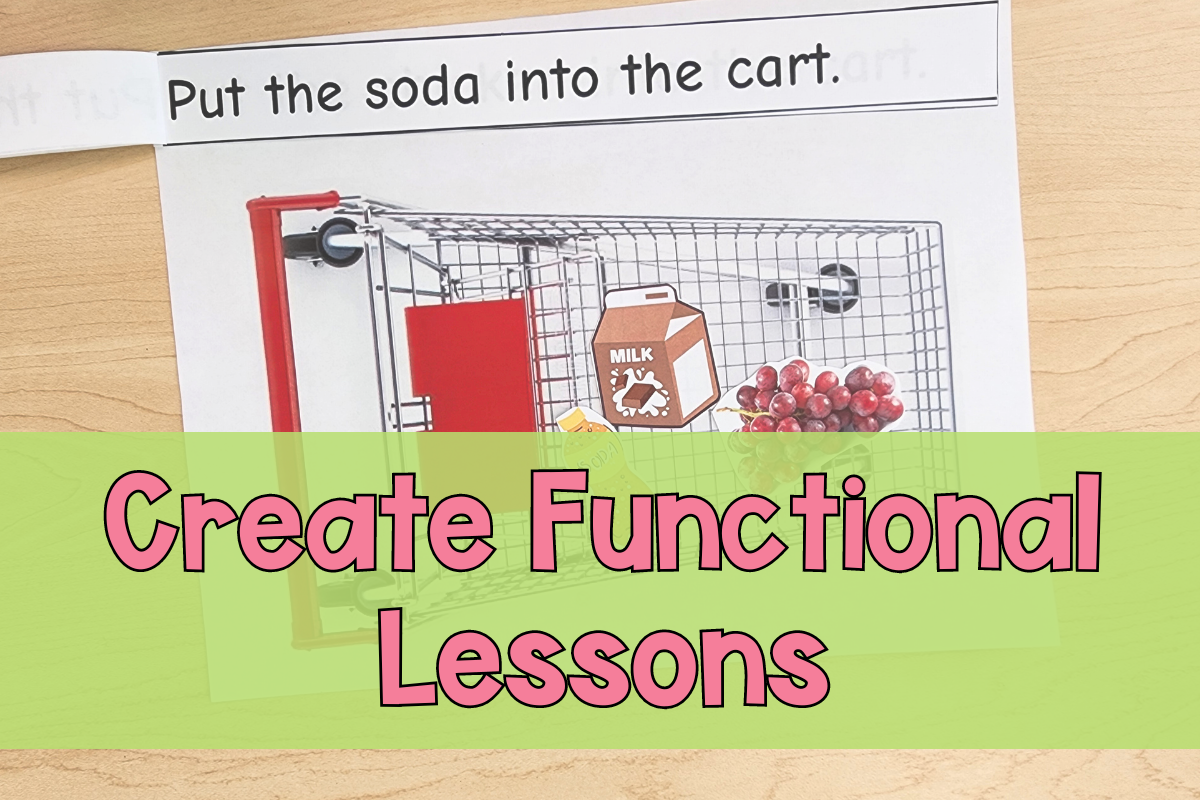The key to creating meaningful functional skills in our students is to embed skills and goals into real-life lessons. Here is a peek into my classroom lesson during our grocery store unit. Read on to learn how to incorporate communication, reading, labeling, and math into one lesson.
We had already introduced vocabulary using the word wall cards and materials in the unit.
Goals for this functional lesson plan:
There were 3 students included in this small group life skills lesson. While each student had similar goals, we were able to easily differentiate within the lesson to meet individual IEP goals.
Goals or outcomes for student 1:
- Point to each word while I read the words to build 1:1 correspondence
- Use the language/core board to request lesson-specific foods
- Be able to complete the “I see ….” statement for his cart.
Goals or outcomes for student 2:
- Read all of the directions independently
- Request food items using descriptors
- Be able to list at least 2 ways her cart was the same and different from peers’ carts
Goals or outcomes for student 3:
- Point to each word while reading the words that are on every page (put, the, cart, etc.)
- Request items using descriptors
- Be able to list at least 1 way her cart was the same and different from peers’ carts
Materials for the lesson
For this lesson, each student had a page with an empty grocery cart. On the top of the page, I stapled 5 directions for what students needed to put in the cart.
I cut out pictures of food items that I knew students liked. I also included items that come in different versions. For example, white, chocolate, or strawberry milk. This gave students a chance to use a descriptor when they requested the item.
Students used the materials in their toolboxes (glue, pencil, etc.) to complete the functional lesson activity.
Tips for completing the life skills lesson
If this is the first time you are using this type of activity in your classroom, you will need to explain and demonstrate to students. Often, I have a para model the student’s part of raising their hand to request the items after we finish reading the sentence.
This model is important because you want to avoid prompting students after every sentence. Asking students questions like “Which do you want?” “What do you need?” are prompts. We want our students to communicate when they need or want something and not wait for a prompt.
This activity also helps students learn to make a choice… an important part of grocery shopping and life! Ways to encourage this may include:
- Including items students don’t eat
- Having only a couple of copies of each food available means students will have to make a backup choice if the item they wanted is no longer available during their turn.
After gluing all of the items into the cart, have students talk about their cart and compare it to pees’ carts. For example, “We both have chicken nuggets, but I have green grapes and you have red.” Depending on your students, you may need to have another visual to help them structure a compare and contrast statement.
Discussing everyone’s carts is a great way to target:
- Labeling
- Commenting
- Using ‘I see…” statements
- Using descriptors
Extending the Functional Lesson
There are many ways to extend this lesson. Using just the materials from this activity, you could:
- Ask students to retell what they put in their cart to someone who wasn’t in the lesson.
- Have students list what else they would put in their carts.
- Direct students to list which category each item is in.
- Have students look up the cost of the items and calculate the total cost.
Moving on from the materials, we would use our grocery store unit to work on identifying the different versions of items, sequence the steps involved in grocery shopping, and practice making lists.
There are so many different ways to combine learning standards, IEP goals, and functional skills. Click the link below to read more.
Targeting IEP Goals In Life Skills Lesson
10 Easy Functional Reading Activities
10 More Functional Reading Activities
(Visited 1 times, 1 visits today)






